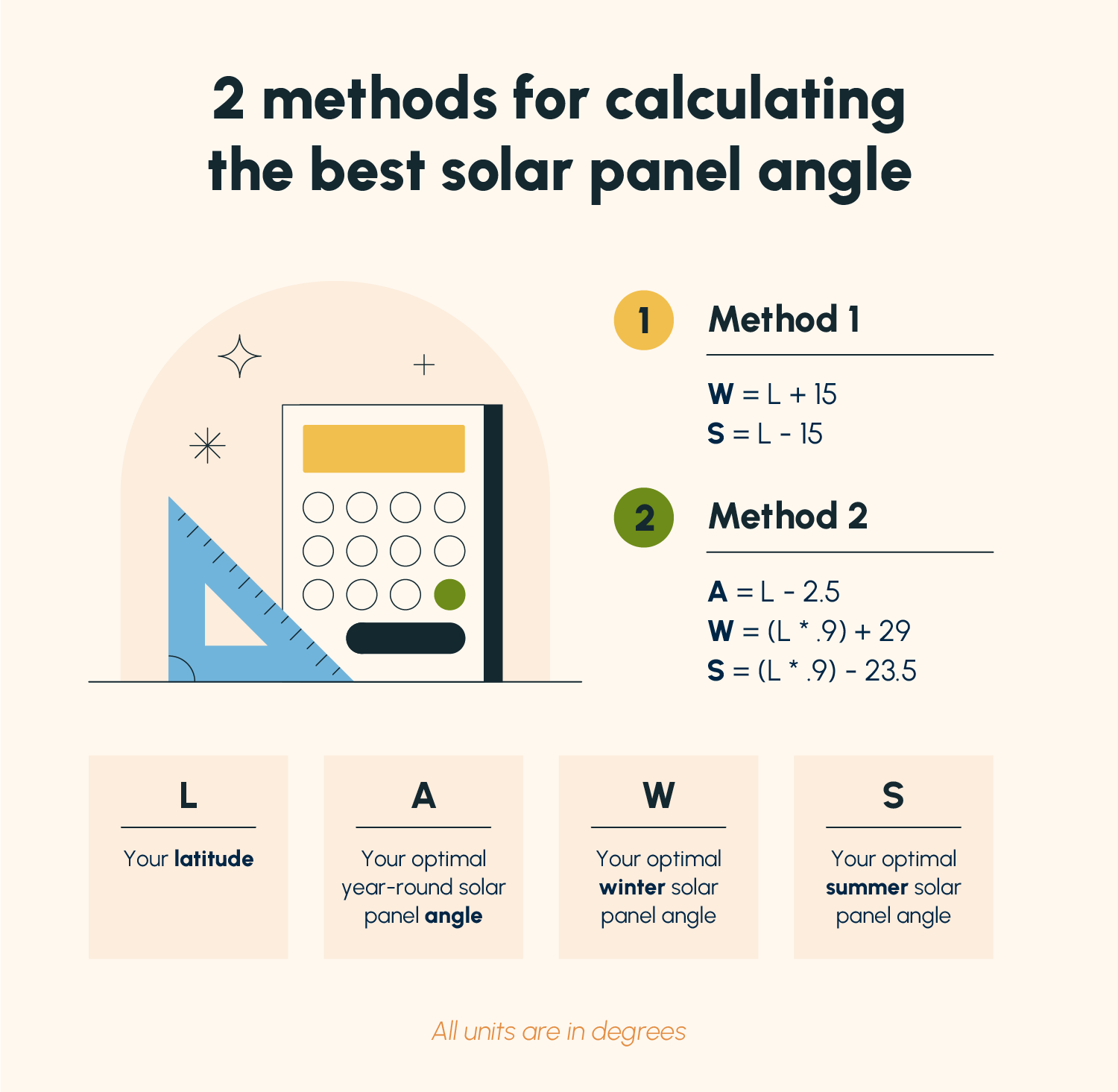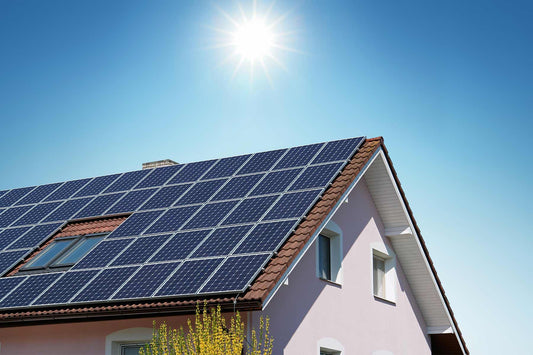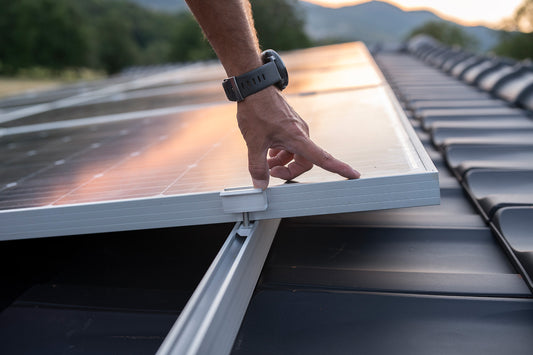Whether you’re new to solar panels or you’ve had them for years, knowing which angle to position them can be tricky. Luckily, it’s easy to calculate the best solar panel angle by ZIP code.
While the correct angle for your solar panels will depend on a number of factors such as the design of your roof, your latitude, and how much snowfall you get, our calculation methods will get you close to that optimal angle.
Below, we’ll dive into the best solar angles for the most populated ZIP codes in America, how to calculate your optimal solar panel angle, and how to adjust your solar panels to that angle.
Best Solar Angles for the Top 800 ZIP Codes in the United States
We compiled the best solar panel angles for the 800 most populated ZIP codes in the United States in the table below.
We explain our calculation method for solar panel angle in full under Method 2.
Why Is the Angle of Your Solar Panel Important?
Solar panels work best when sun rays hit them perpendicularly. This means that to achieve maximum efficiency, your solar panels would have to be moving all day, adjusting with the sun.
Since that’s impossible for most home solar panel setups, the optimal solar panel angle will ensure your solar panels are operating as efficiently as they can. This will generate more energy and save you more money on your electric bill.
Factors That Affect Solar Panel Angle
Five main factors affect the optimal angle for your solar panels: latitude, roof design, season, solar panel direction, and temperature.

Latitude
Depending on where you live, you’ll have different optimal angles for your solar panels. For the vast majority of U.S. property owners, the best angle for solar panels will be close to the latitude of your home, which typically falls between 30º and 45º.
If possible with your roof design, have your installer use brackets to angle your panels according to your area’s specifications.
Roof Design
Considering the design of your roof is critical when installing solar panels. If your roof is angled within 10º of your ZIP code’s optimal angle, it’s best to just install your solar panels flat on your roof, rather than at an angle.
If you use brackets and angle your solar panels on an already steep roof, you risk shading the panels below it. Consider talking to a contractor about how your roof’s design will impact solar panel installation.
Season
The Earth’s movement around the sun dictates the seasons, so it should come as no surprise that time of year impacts your ideal solar panel angle.
Specifically, the best angles for winter are higher than the best angles for fall and spring, which are higher than the best angles for summer. Refer to the table above for exact numbers.
Solar Panel Direction
If you’re installing solar panels in the Northern Hemisphere, your solar panels will do best when they are facing true south. If they aren’t facing an optimal direction, angling your panels effectively matters even more, because they’ll receive less sunlight than if they were facing true south.
True south can be found using Google Maps, or by measuring the shadow of an upright object in the ground at your location’s solar noon. Determining your location’s solar noon requires some math, so we recommend just using the Internet.
Solar trackers are also an option to help generate more power. These are devices that move your solar panels to follow the movement of the sun, guaranteeing maximum efficiency at all times of the day.
However, solar trackers have drawbacks. Their high price tag can make it more cost-effective to simply install more solar panels instead. They are also not usually suited for residential projects, as you cannot install them on most roofs. If you are installing ground-mounted solar panels, a solar tracker can be a helpful addition to maximize the utility of your solar panels.
Temperature
At temperatures above 95º Fahrenheit, solar panels start losing efficiency. In the summer, panel temperatures can reach well above that, which is why you may see reduced energy production in the summer months.
If you live in a hot area, it can be worthwhile to install solar panels with heat-reducing measures in mind. For example, consider installing your panels with brackets that elevate them, both improving their positioning and increasing airflow underneath them, lowering their temperature.
Methods for Calculating the Best Solar Panel Angle
If you live in an area that isn’t listed in the table above, there’s no need to worry. There are two very easy ways to calculate your solar panel’s optimal angle based on your latitude, which you can easily determine using your ZIP code.
Method 1
The first calculation method is very simple. You just take your latitude and add 15º for the optimal winter tilt angle, and subtract 15º for the optimal summer tilt angle.
Method 2
The second calculation, while more complicated than the first, yields more accurate results.
To calculate the optimal year-round tilt angle, take your latitude and subtract 2.5º. For the optimal winter tilt angle, take your area’s latitude, multiply it by .9, and then add 29°. For the optimal summer tilt angle, multiply your latitude by .9, then subtract 23.5°.
For example, if your latitude was 36°, your desired year-round tilt angle would be 33.5°, your optimal winter tilt angle would be 61.4°, and your best summer tilt angle would be 8.9°.
We used this method to calculate the angles in the above table. We sourced data from the 2010 Census for population by ZIP code, put them through a latitude calculator, and used this data in our calculation.

Adjusting the Angle of Your Solar Panels
If you have ground-mounted solar panels and you live in the Northern hemisphere, the best time to adjust your solar panels to their summer setting is on March 30, while the best time to adjust to their winter setting is on September 10.
If you intend to adjust your solar panel angle throughout the year, it’s best to get them fitted with adjustable brackets when you install them. Otherwise, it may be difficult to adjust the angle later.
There isn’t one set way to adjust your panels—it’ll vary from bracket to bracket. Usually, this involves either loosening a few bolts and tilting your panels by hand or using a wrench. When in doubt, refer to your brackets’ instruction manual.
Solar Panel Angle by ZIP Code FAQ
While positioning your solar panels, you may have one of these frequently asked questions.
How Important Is the Angle for Solar Panels?
Solar panel angle is very important for solar energy production, as your panels will produce maximum energy when directly perpendicular to the sun.
Do Solar Panels Still Work in Winter?
Solar panels still work in winter, and may even work better than they do in summer. They gather energy from the sun’s light directly, not the heat generated by sunlight.
That said, if you live in a snowy climate, it’s a good idea to have your panels installed at an angle if your roof is flat — snow collection can eventually impede solar energy production.
Does Rain Damage Solar Panels?
No, rain doesn’t damage solar panels. In fact, rain can help solar panels work more efficiently by clearing dust and debris from the surface. If you live in an area with drought, you may need to clean them yourself every so often.
Solar panels have their pros and cons, but if you choose to install them, you’ll want to get the most out of your money. By considering the best solar panel angle by ZIP code, you can maximize your solar output right from the get-go.
If you’re looking to install solar panels for your home, be sure to check out our residential solar panel options.




